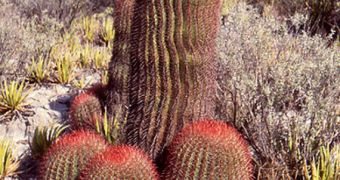Researchers managed recently to discover the origins of a special type of domesticated cactus. They tracked the original plant to the Tehuacan Valley, in Mexico.
Ever since humans first managed to domesticate plants, other species of vegetation have been threatened, or brought to the brink of extinction, because of it.
This was not the case with the Gray Ghost Organ Pipe (Stenocereus pruinosus) cactus, a domesticated plant whose origins apparently stretch a while back, AlphaGalileo reports.
Experts studying the domestication process of modern-day plant varieties say that their work is made considerably hardened by the fact that the precursor species – from which the modern plants evolved – have been destroyed during the domestication process.
As such, the accomplishment by researchers at the Universidad Nacional Autonoma de Mexico (UNAM) is even more impressive.
The team here, led by expert Fabiola Parra, managed to track down the domesticated cactus variety to a living ancestor, currently confined to the Tehuacan Valley.
Details of the research will appear in the September issue of the esteemed journal Annals of Botany.
“What we found is that the people of the Tehuacan Valley are carefully selecting and cultivating cacti to produce the pitaya they want,” says Dr. Alejandro Casas, who was a member of the research team.
“They're not attempting to produce one type of pitayo. They have a rich understanding of the cacti and are able to produce fruits with a variety of colors and tastes,” adds the expert, which is an etnobotanist.
Pitaya are the fruit of cacti, and the main reason they were domesticated in prehistory in the first place.
“We found that the forest cacti showed more diversity in their genes than expected. It is not a case of finding a simple transition from wild to domesticated plants,” the team member argues.
“The methods of propagation of cacti by the traditional farmers, including the production of a variety of fruits, help increase the genetic diversity of the cacti. This is a crucial strategy in conserving the genetic resources of Mesoamerica,” he adds.
“In contrast agriculture in the industrialized world aims for mass-produced conformity in fruit,” Casas believes.
The success of the new study was only made possible through a series of genetic analysis, conducted on the DNA material of both the wild and the domesticated versions of the Gray Ghost Organ Pipe.
“Mesoamerica is a real laboratory for the study of evolution and domestication is one of the most important ways available for studying the evolutionary process,” adds UNAM biologist Dr Mark Olson, who was not a part of the investigation.

 14 DAY TRIAL //
14 DAY TRIAL //